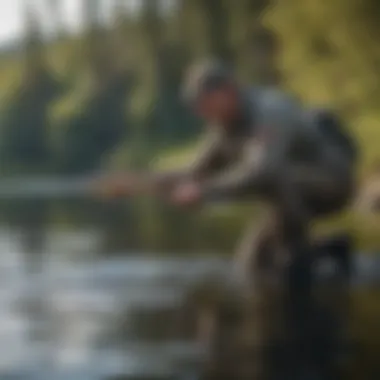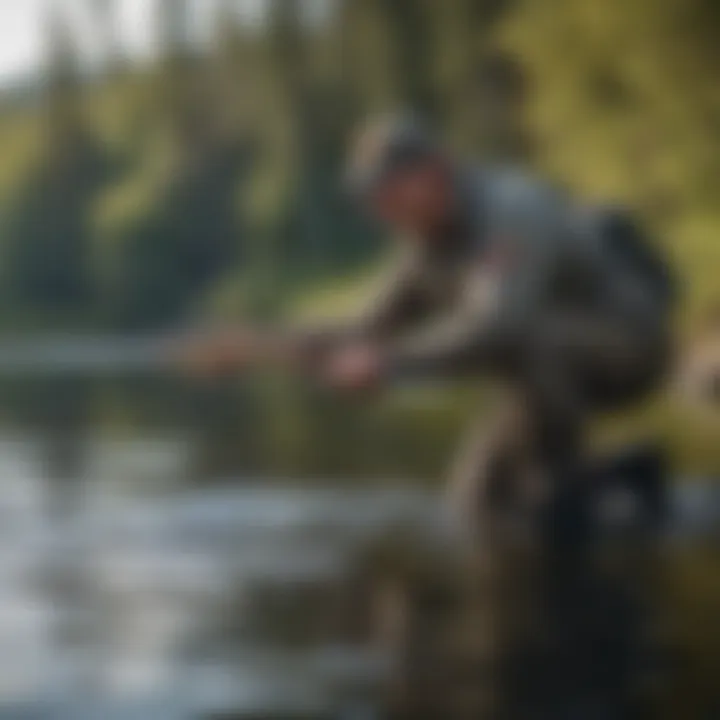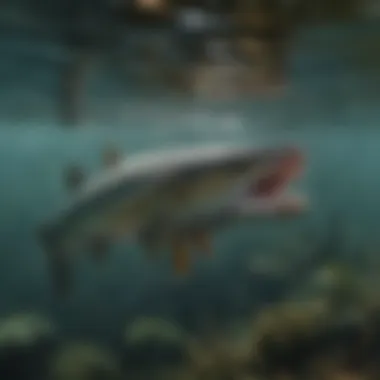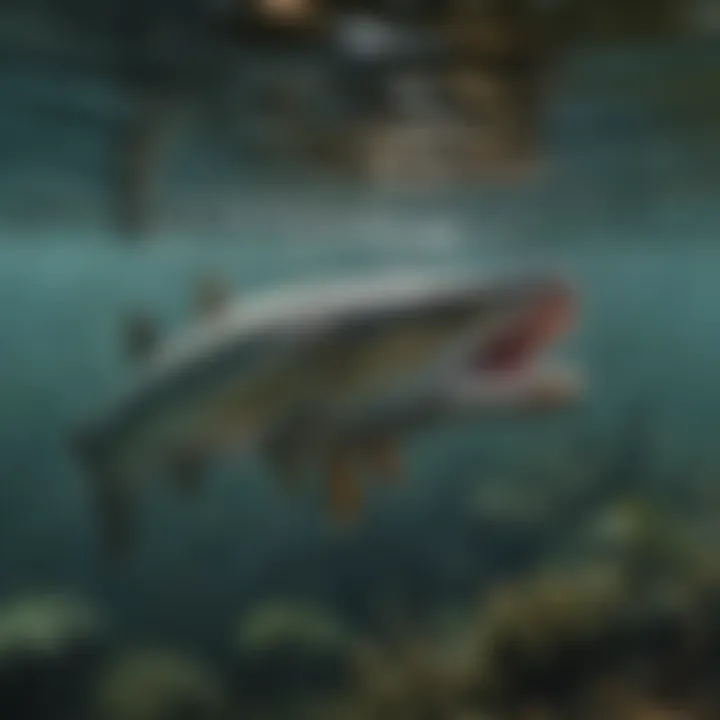Mastering Musky Fishing in Canada: Techniques and Tips


Overview of the Topic
Intro to Musky Fishing in Canada
Musky fishing in Canada offers a thrilling and often challenging experience for anglers. Known for their elusive nature and impressive size, muskellunge, or muskies, are revered for their aggressive strikes and strategic fights. Found primarily in the vast lakes and rivers of Canada, these fish have drawn enthusiasts seeking both the rush of the catch and the serenity of the great outdoors.
The muskellunge is not just a fish; it embodies a significant aspect of angling culture that intertwines recreational enjoyment with environmental stewardship. Many fisheries are closely monitored and managed to ensure that these remarkable fish can be enjoyed by generations to come. Conservation efforts highlight the keen ecological importance of muskies, which play a vital role in their ecosystems, controlling the populations of smaller fish species and maintaining the health of aquatic habitats.
Background on the Significance of the Topic
The significance of muskies extends beyond the realm of fishing. They are a critical indicator of lake and river health, showcasing the integrity of freshwater ecosystems. Their presence often reflects a balanced environment, making the musky a focal point for conservationists and biologists alike. By understanding musky fishing and its impacts, we can better appreciate not only these stunning creatures but also the complex web of life in Canadian waters.
It's worth noting that musky fishing touches on broader environmental discussions. The practices and techniques employed in catching these fish provide insight into sustainable fishing methods and highlight the delicate balance between recreational activities and the preservation of natural resources. The integration of conservation into fishing is essential, as it ensures that future anglers will have the opportunity to experience the thrill of catching musky in Canada.
Current Status and Challenges
Examination of Current State
Today, Canada holds some of the most premier musky fishing locations in the world. With provinces like Ontario and Quebec boasting numerous lakes known for their hearty musky populations, the sport is not only popular but growing. However, this increase in interest brings with it challenges that have led to a variety of conservation concerns.
Muskellunge populations have seen fluctuations due to various factors. While some bodies of water are thriving with musky activity, others are witnessing declines caused by habitat destruction, pollution, and overfishing. These challenges require the attention of both anglers and conservationists to ensure that the species continues to flourish in its natural habitat.
Identifying Challenges and Threats
- Habitat Loss: Development around waterways often leads to the destruction of essential fish habitats. Dredging, damming, and shoreline development can erode spawning grounds.
- Water Pollution: Agricultural runoff and urban waste can severely impact water quality, affecting the health of the musky and their prey.
- Overfishing: Though regulations exist, illegal fishing and lack of adherence to catch limits can threaten small populations, especially in local areas.
- Invasive Species: Non-native species, such as the zebra mussel, compete for resources and disrupt the ecosystems that muskies depend on.
Sustainable Solutions
Exploration of Sustainable Practices
The path to preserving musky populations lies in sustainable practices that respect both the species and their habitats. Anglers are increasingly adopting measures that reduce their impact on the environment. These practices can include:
- Catch and Release: Promoting the careful release of caught muskies helps maintain population levels.
- Respecting Regulations: Following local fishing laws and guidelines ensures that any fishing activity is sustainable.
- Habitat Restoration Projects: Many organizations are actively working to restore and protect aquatic habitats, fostering healthier ecosystems for muskies to thrive.
Successful Case Studies
Various success stories illustrate the effectiveness of conservation efforts in promoting sustainable musky fishing. For instance, the Muskie School of Ontario has taken steps to educate anglers on best practices while advocating for stricter regulations to protect vulnerable populations. Likewise, community-driven initiatives aimed at cleaning up local waterways have shown promising results in improving overall water quality and habitat conditions.
Impact and Importance
Analysis of Impact on Ecosystems and Communities
The musky, often termed as the fish of 10,000 casts, is symbolic of the patience and respect required in the sport of fishing. Their significance stretches to the broader community, economically benefiting local economies through tourism and recreational fishing activities. The impact of sustainable fishing practices reaches into the heart of communities as they thrive with a responsible approach to resource management.
Emphasis on Conservation Efforts
To ensure that musky populations remain healthy for future generations, conservation efforts must be prioritized. These include ongoing education about the ecological significance of maintaining healthy fish populations and habitats. The balance needed between recreation and conservation serves as a reminder of our responsibility as stewards of nature, protecting not just the musky, but the overall health of Canadian aquatic ecosystems.
"A true fisherman knows that the act of fishing is as much about preserving nature as it is about the catch."
In summary, musky fishing in Canada represents a critical intersection of sport, ecology, and conservation. By embracing sustainable practices and understanding the challenges faced, anglers can contribute positively to the future of this ancient sport and the majestic fish that make it so enthralling.
Prolusion to Musky Fishing in Canada
Muskellunge fishing holds a distinct place in Canada’s vast outdoor traditions. This intense sport not only offers the thrill of the catch but also fosters a deeper understanding of aquatic ecosystems and promotes conservation efforts. Passionate anglers often hold muskellunge in high regard, viewing them as a majestic challenge due to their elusive nature and formidable size. Practicing this sport encourages not only the honing of skills but also a profound respect for the environment.
The Significance of Muskellunge
The muskellunge isn't just another fish to chase; it plays a pivotal role in maintaining a balanced ecosystem. As apex predators, muskies help regulate populations of smaller fish, making their conservation essential for a flourishing aquatic environment. Local anglers often share tales of the sheer adrenaline rush involved in targeting these formidable creatures.
An impressive muskellunge can surpass 50 inches in length and weigh over 40 pounds. Their distinct mottled skin has made them a favorite among fans and artists alike, inspiring numerous fish-themed artworks and media. Beyond the fishing experience, they symbolize resilience and strength, qualities that resonate deeply within communities that cherish nature.
Historical Context in Canadian Angling
The history of musky fishing in Canada is steeped in rich traditions tied to the land and its people. Indigenous cultures have revered this fish for generations, not only for its role in the natural world but also as a source of sustenance. Early settlers adopted angling techniques, blending them with Indigenous practices, thus shaping a unique fishing culture.
In the 19th century, musky fishing began to gain popularity among sport anglers, particularly in provinces like Ontario and Quebec, which are known for their bountiful waters. Organizations began to emerge, committed to promoting responsible fishing practices and creating awareness about the muskellunge's ecological threats.
Countless stories abound about anglers traveling from near and far, armed with the latest techniques and gear, to embark on adventures of catching and releasing these elusive fish. This commitment to the sport, its history, and its significance speaks to a greater understanding of environmental stewardship, which continues to evolve today as conservationists emphasize sustainable fishing practices.
"The struggle for a musky can be both joyous and frustrating, but every angler knows that patience and respect for nature yield the most rewarding experiences."
The culture of musky fishing in Canada is anchored in community. Regularly, gatherings of angling clubs and conservation groups rally outdoors to share knowledge, stories, and strategies for preserving the species. As enthusiasts rally behind educational initiatives, the collective narrative of this sport continues to meld with conservation efforts, shaping the future of both the angling community and muskellunge populations.
Understanding the Muskellunge Species
In grasping the intricacies of musky fishing, understanding the muskellunge species is paramount. This knowledge not only enriches the fishing experience but also enhances conservation efforts. Knowing the muskellunge helps anglers appreciate its role within the ecosystem and promotes sustainable fishing practices. Furthermore, being well-informed about the species can lead to better fishing techniques and increase chances of a successful catch, which is often the goal for many enthusiasts.


Physical Characteristics
Muskellunge, or Esox masquinongy, exhibit distinctive physical attributes that set them apart. Their elongated bodies can grow as long as 60 inches and weigh up to 80 pounds or more in some cases! Their coloration is quite striking; typically, they sport a light greenish-gray tone adorned with vertical darker stripes, which can be helpful for camouflage in weedy waters. The fish possesses an array of sharp teeth, designed for capturing slippery prey, which mainly consists of fish like perch and bluegill.
In addition to their impressive size, muskies have elongated, paddle-like tails that aid in powerful bursts of speed. This capability is noteworthy, especially during the fight when they often leap and thrash about, making for a thrilling encounter. Their keen eyesight allows them to hunt efficiently, both in murky waters and bright sunlight, making them a formidable predator in their habitat.
Habitats and Distribution
Muskellunge can be found primarily in the freshwater lakes, rivers, and wetlands across a swath of North America, particularly in Canada. They tend to favor areas with plenty of cover, such as submerged trees, rock piles, and weed lines, where they can ambush prey. The shifting patterns of coastal waters in Lake Ontario, as an example, create ideal conditions for these fish to thrive.
A few notable provinces where muskies are abundant include:
- Ontario: Home to some of the largest musky populations anywhere.
- Quebec: Features a variety of lakes that support this species.
- Manitoba: Offers hidden spots for anglers willing to explore.
Interestingly, these fish also don't shy away from experiencing seasonal changes in their environment. In colder months, you might find them deeper in the water, retreating from the chilly surface temperatures.
Reproductive Behavior and Lifecycle
The reproductive habits of muskellunge are as fascinating as their physical traits. Muskies primarily spawn during the spring when water temperatures hit 60 degrees Fahrenheit. This period is crucial as it marks the time when females lay their eggs in shallow, vegetated areas, ensuring that the developing fry have ample protection from predators.
Once the eggs are laid, the female muskellunge typically leaves to return to deeper waters, while the male stays to fertilize the eggs. The larval muskies emerge within a week or two, and they rely on their yolk sacs for nourishment until they're capable of hunting on their own.
The muskellunge lifecycle is a dance of survival and strength. From juvenile fish growing quickly while avoiding predators in their early days, to mature individuals asserting dominance in their habitat, each chapter is critical to the species' continuity. Interestingly, some muskies have been known to live 20 years or more, making them not only a catch but a long-standing part of the ecosystem.
"Muskellunge are not just fish; they are an integral part of the ecosystem, influencing both habitat and prey populations."
In summary, understanding the muskellunge species encompasses much more than just identifying the fish itself. This knowledge fosters a connection to the broader ecological context and informs responsible fishing practices, which are essential for preserving this majestic species for future generations.
Fishing Techniques for Musky Anglers
When it comes to musky fishing in Canada, mastery of various techniques can greatly influence your success. The methods used are not just random choices; they are rooted in understanding the behavior and habitat of the elusive muskellunge. Employing different fishing techniques enables anglers to adapt to shifting conditions and enhances the chances of hooking a musky.
Trolling Strategies
Trolling is one of the proven ways to target muskies. This technique involves pulling lures behind a moving boat to cover a vast area of water, increasing the probability of encountering a fish. The key here is to maintain a steady speed and vary your depth by adjusting your lure's weight.
Using two or more rods can also be advantageous as it helps to increase your strike rate. Anglers often employ specific trolling lures, like swim baits or large crankbaits, ideally those that mimic distressed prey. Each lure creates a different action in the water and can entice muskies in various moods.
"Trolling for muskies is like playing chess with the water; every move can lead to a checkmate or a complete bust."
Casting Methods
Casting is another favored technique among musky anglers. This method allows for precise placement of lures in strategic locations, such as around structure like submerged rocks or fallen trees. Learning to cast accurately is vital; it gives you a fighting chance to present your lure in the most enticing way.
Key casting tips include:
- Focus on Structure: Muskies often lurk near weed beds, logs, or drop-offs.
- Pace Your Retrieves: Vary the speed when reeling in. Muskies can follow a lure but need a little kick to spark their predatory instincts.
- Use Big Lures: Don't shy away from hefty lures; muskies are not small fry!
Fly Fishing Techniques
Fly fishing for muskies is less common, but it offers a unique experience. This method requires special gear and a different mindset. Casting large, heavy flies can be physically demanding, but the thrill of hooking a musky on a fly more than compensates for the effort.
Considerations for fly fishing include:
- Fly Size: Use large streamers or musky-specific flies that imitate baitfish.
- Proper Gear: A stout rod and reel capable of handling the fight of a musky is paramount.
- Stripping Techniques: Utilize distinct stripping methods to create life-like actions. Experiment with pauses and quick jerks.
While fly fishing for musky may not be for everyone, it definitely brings an exciting spin to the traditional angling methods.
By understanding these fishing techniques—trolling, casting, and fly fishing—anglers can tailor their approach to each outing. Adapting techniques based on conditions, fish mood, and personal preference can result in more fruitful trips and a deeper appreciation for the sport.
Essential Gear for Musky Fishing
When it comes to musky fishing, one cannot overstate the role that proper gear plays in achieving both success and enjoyment on the water. The muskellunge, often referred to as the “fish of 10,000 casts,” is known for its elusive nature and powerful fight, which makes choosing the right equipment absolutely critical. Having the right gear not only increases the chances of catching one of these incredible predators but also enhances the overall fishing experience.
Rod and Reel Selection
Selecting the right rod and reel is the cornerstone of any successful musky fishing expedition. A musky rod typically ranges from 8 to 10 feet in length and is designed to handle heavy lures and withstand the intense fight of a musky. A sturdy rod with a strong backbone is essential, as muskies can weigh over 30 pounds and are known to make jaw-dropping leaps that can easily throw off an inexperienced angler.
When it comes to reels, baitcasting reels are often favored due to their greater control and ability to manage heavier lines. Look for reels with strong drag systems capable of exerting enough pressure to tire out a musky while still providing the angler with the necessary adjustments to avoid break-offs. A gear ratio between 5:1 and 7:1 is generally ideal for retrieving lures quickly and efficiently.
"In my years of fishing muskies, I've found that a well-balanced rod and reel combo makes a world of difference in keeping rhythm while casting and retrieving."
- An experienced musky angler
Choosing Appropriate Lures
Lures are the pinnacle of musky fishing, and choosing the correct ones can be as daunting as the fishing itself. Muskies are apex predators, often drawn to large, flashy, and erratic movements. Depending on the season and water conditions, here are some effective lure types:


- Topwater Lures: Great for summer months when muskies are aggressive. They create surface commotion, catching the attention of nearby fish.
- Crankbaits: These can mimic the motion of wounded fish and are often effective in the cooler months when muskies are less active.
- Swimbaits: Their realistic swimming action proves irresistible to muskies. Choose larger sizes for better visibility.
- Bucktails: These classic lures are often used for both casting and trolling. Their versatility makes them a go-to option.
Keep in mind the color of lures complements the water conditions. Bright colors tend to work well in murky waters, while natural colors shine in clear water. Fish size and location versatility are also crucial factors to consider.
Importance of Fishing Line Strength
The strength of your fishing line can make or break a musky fishing trip. A line that is too weak runs the risk of snapping during a fight with a large musky. Typically, anglers should use braided line with a strength of 80 to 130 pounds. Braided lines offer the benefit of low stretch and high sensitivity, helping anglers detect even the most subtle bites.
Moreover, using a leader line, often made of fluorocarbon or steel, is essential to prevent sharp-toothed muskies from biting through your line. The length and thickness of the leader depend on the lure type and fishing conditions. A thicker leader is generally better for larger lures, while lighter ones can be used for finesse presentations.
In summary, having the right gear contributes significantly to your overall success and enjoyment in musky fishing. Choosing the appropriate rod and reel combo, selecting effective lures tailored to conditions, and using a strong fishing line will enhance your experience and increase your chances of landing that elusive musky.
Prime Musky Fishing Locations in Canada
Musky fishing in Canada isn't just about catching fish; it's about immersing oneself in the diverse environments where these magnificent creatures thrive. Identifying the prime fishing locations is crucial for enthusiasts, as it significantly influences both the angling experience and the likelihood of success. From expansive lakes to winding rivers, each setting offers unique challenges and opportunities, allowing anglers to develop their skills while contributing to the conservation of diverse aquatic ecosystems.
Understanding where to fish is essential—not only for maximizing catches but also for appreciating the scenic beauty and biodiversity these locations present. In this section, we explore some of the best regions across Canada, each teeming with its own musky hotspots.
Ontario's Notable Waters
Ontario stands tall among the provinces known for thrilling musky fishing experiences. The vast lakes, including Lake St. Clair, Lake Nipissing, and Ottawa River, create an intricate mosaic of waterways. Each location offers different features:
- Lake St. Clair: With its weedy bays and structured shorelines, this lake is renowned for its high musky populations. The shallow waters make it ideal for casting, especially during the warmer months when muskies are more active.
- Lake Nipissing: This large, shallow lake is perfect for both novice and seasoned anglers. The musky here can be quite a bit larger, and finding the right spots—like rocky outcrops—can yield exciting results.
- Ottawa River: Known for its rapids and expansive pools, the Ottawa River offers a range of fishing challenges. Both the scenery and the thrill of reeling in a musky in this flowing water can’t be overlooked.
Quintessential Quebec Locations
Moving over to Quebec, we see a rich tapestry of waterways that serve as prime musky habitats. Quebec's lakes and rivers, such as the Lac des Deux Montagnes and the Saguenay River, provide extensive opportunities for fishing.
- Lac des Deux Montagnes: An excellent choice for anglers looking for a variety of environments, this lake contains various structures, from sunken timber to sprawling weed beds. The strategic depth changes offer prime hunting grounds for musky, especially from late spring to early fall.
- Saguenay River: This body of water not only allows for musky fishing but also provides remarkable backdrops. The river's strong currents and deep pools make it challenging but rewarding for those seeking larger fish.
This blend of beauty and angling opportunity has made Quebec a must-visit destination for musky enthusiasts.
Hidden Gems in Manitoba
When it comes to hidden gems, Manitoba holds its own with lesser-known yet exceptional musky fishing spots. Places like Lake Winnipeg and Caddy Lake are often overshadowed by more popular locales but offer fantastic chances for success.
- Lake Winnipeg: Known more for its walleye runs, but the musky fishing can surprise many. The vastness of the lake allows for exploration, beckoning those willing to scout for remote fishing spots.
- Caddy Lake: Nestled in the Whiteshell Provincial Park, this smaller, picturesque lake is often overlooked but delivers solid musky action. The shallow bays and rocky shoals provide prime ambush points for anglers chasing muskellunge.
Visiting these lesser-known locations not only adds variety to the fishing experience but also supports local ecosystems and conservation efforts.
The landscapes where muskies reside often reveal the profound connection between angling and nature conservation. Recognizing these spots fosters a deeper appreciation for the environment.
In summary, musky fishing locations in Canada reflect a melange of angling potential and conservation commitment. Recognizing these hotspots and their unique attributes forms an integral part of the overall musky fishing experience. By understanding where to go, anglers can enhance their skills while embracing the responsibility of protecting these vital habitats.
Seasonal Considerations for Musky Fishing
Understanding the seasonal dynamics of musky fishing is crucial for any angler serious about landing a trophy fish. Muskellunge are notably influenced by temperature fluctuations and aquatic life cycles, which means fishing success tends to ebb and flow with the changing seasons. This section dives into important factors that every musky enthusiast should consider to optimize their fishing strategy.
Best Times of Year for Musky Fishing
Muskies are often considered a challenging species to catch, and rightfully so. But knowing the best times of year can be a game changer. Typically, the peak season for slaying these elusive fish stretches from late spring into early fall. More specifically, the late summer months, particularly July and August, often yield the most action.
During these warmer months, muskellunge are more active, feeding aggressively to prepare for the colder months ahead. Anglers frequently report success in the early hours of the morning or just before dusk, when these predators are most likely to strike. Water temperatures around 70 to 78 degrees Fahrenheit seem to hit the sweet spot for musky activity.
Weather Influences on Fishing Success
Weather can dramatically impact musky behavior, and savvy anglers keep their eyes on the sky. Cloud cover, for instance, is often a boon for fishing, as muskies tend to venture into shallower waters during overcast days. Conversely, high-pressure systems can make these fish skittish and less likely to bite, pushing them deeper into the waters.
Moreover, the wind plays a significant role. A light breeze can help disguise an angler's movement on the lake surface, providing a favorable environment for a successful catch. Conversely, storm systems can offer a double-edged sword: while they might momentarily disrupt bites due to changing atmospheric conditions, the hours after a storm can rejuvenate the musky feeding frenzy.
Adapting Techniques with Changing Seasons
Adjusting your fishing techniques in response to seasonal changes isn't just smart; it's essential. In spring, as waters begin warming, focus on shallower areas where muskies are preparing to spawn. Techniques like casting jerkbaits can be particularly effective given muskies are more aggressive during this period.
As summer fades into fall, the fish's behavior shifts again. They will often begin moving to deeper waters as they prepare for winter. Adjusting tactics to include techniques like trolling or using heavy spinners becomes necessary. It can also be beneficial to target areas where prey fish are congregating, such as near weed beds or drop-offs.
Ultimately, learning to identify these seasonal shifts can be your ticket to a more fruitful musky fishing experience. Each season not only brings a change in fish behavior but also new scenery, making the journey all the more rewarding.
"The beauty of musky fishing isn't just the catch; it's understanding nature's rhythm and adapting to it."
Throughout the year, patience and adaptability are essential. Each season holds its own charm, promising a unique adventure on the water.
Conservation Practices for Muskellunge
Maintaining healthy muskellunge populations is crucial not only for the sport of fishing but also for the broader ecosystem in Canada. These magnificent fish play an integral role in aquatic food webs, and their well-being is a reflection of the health of their environment. Engaging in effective conservation practices is essential to ensure that future generations can enjoy musky fishing while preserving the delicate balance of their habitats.
Understanding the Ecosystem Impact


Muskellunge, often referred to simply as "musky," are apex predators in freshwater systems. They help control populations of smaller fish, contributing to a balanced ecosystem. When musky populations decline, there can be overpopulation of their prey, leading to significant changes in the aquatic environment. This ripple effect can alter the habitat for many other species, directly impacting biodiversity.
"A healthy musky population signifies a well-balanced ecosystem. If the musky are thriving, it’s usually a good indicator that the water quality is also suitable for other aquatic life."
Promoting the understanding of how musky fit into the broader ecological picture is vital. Educating anglers and the public about these impacts can help promote responsible fishing practices and encourage support for conservation initiatives.
Catch and Release Best Practices
One of the most critical components of musky fishing conservation is the practice of catch and release. Muskellunge are sensitive fish, and improper handling can cause stress or injury that may reduce their chances of survival once returned to the water. Here are some best practices:
- Minimize Air Exposure: Keep the fish in the water as much as possible while removing hooks.
- Use Barbless Hooks: This makes it easier to remove hooks and reduces injury.
- Support the Fish Properly: When lifting the fish for photographs, ensure it is supported under its body to prevent damage to internal organs.
- Revive the Fish Before Release: After unhooking, gently hold the fish in the water, moving it back and forth to ensure water flows over its gills.
Implementing these practices not only helps maintain the musky populations but also embodies the spirit of responsible angling.
Collaborative Conservation Initiatives
Conservation of muskellunge is not a solitary endeavor; it requires collective efforts from various stakeholders. Fish and wildlife agencies, local fishing communities, and conservation groups can work together to promote effective strategies for sustaining musky populations. Examples of collaborative initiatives include:
- Habitat Restoration Projects: Many organizations are focused on restoring habitats through planting native vegetation and removing barriers that impede fish migration.
- Data Sharing Programs: Fish tracking and data collection can help in understanding musky behaviors and population dynamics. This shared information can lead to more informed management decisions.
- Public Awareness Campaigns: Engaging the community through workshops and events can raise awareness about the importance of preserving musky habitats and sustainable fishing practices.
By working together, all stakeholders can help ensure that muskellunge populations thrive, benefiting not just anglers but also the ecosystem as a whole.
Personal Stories from Experienced Anglers
When it comes to musky fishing, the tales spun by seasoned anglers hold a unique value. Their experiences not only bring life to the practice but also provide insights that technical guides often overlook. These personal stories reflect the challenges, triumphs, and, more importantly, the lessons learned while pursuing muskellunge in the vast waters of Canada. They remind us that successful fishing isn't just about technique or equipment; it’s about the emotional connection to nature and the thrill of the chase.
Lessons from the Water
Every angler has a story that starts with a lesson learned the hard way. For example, an experienced musky fisherman named Mike shared his story of persistence. One frigid morning in Northern Ontario, after hours of casting with no bites, he decided to change strategies. Instead of relying on his go-to lures, he switched to a topwater frog._ "Sometimes you gotta think like a fish,"_ he said, recalling the moment he saw that first explosive strike. This change not only led to a catch but also reinforced a vital lesson learned: adaptability on the water can turn the tide.
Moreover, anglers often highlight the significance of patience in musky fishing. Jane, an avid angler from Quebec, relates a time when she tied on a lure that had been collecting dust in her tackle box. After a slow start, her patience was rewarded when a massive musky grabbed it, teaching her that sometimes the best opportunities lie in the most unexpected places. These stories serve as reminders that not every outing will yield instant results, but each trip contributes to a greater understanding of both the fish and the environment.
Memorable Catches and Experiences
The stories of memorable catches are often the most cherished among anglers. They encapsulate the excitement, the suspense, and even the unexpected elements that come with fishing. For instance, consider Frank, who vividly recounts his encounter while fishing in the waters of Lake of the Woods. After a long day of fishing without much success, a sudden tug on his line turned into a battle for the ages. "It felt like a freight train was pulling me into the depths,” he remarked. After a tense few minutes, he finally landed a 50-inch musky, an experience so exhilarating that he still talks about it years later.
What makes these stories even more magical is the bond formed between friends or family during these outings. An angler named Sophia recalls a fishing trip with her father. They didn’t catch much that day, but the shared moments spent casting lines, laughing, and soaking in the lake's beauty created memories that would last a lifetime. She realized that the thrill of fishing is not just about the musky, but also the stories that unfold along the way.
"Fishing isn't just about filling the cooler; it's about the experiences you take home with you."
— Sophia, passionate musky angler
Engaging in personal narratives such as these not only builds a community of fellow fishing enthusiasts but also contributes to the broader ethos of conservation. Recognizing the shared experiences fosters a sense of responsibility toward protecting the habitats that enable these memorable catches. These tales, rich with detail and emotion, resonate well beyond the fishing community, educating newcomers and raising awareness about the importance of conservation efforts for future generations.
Future Trends in Musky Fishing
The world of musky fishing is not static; it's always changing and adapting. Anglers, as well as conservationists, must keep an eye on emerging trends to both increase their success on the water and preserve these magnificent fish for future generations. The increasing emphasis on sustainability and advancements in technology are steering this age-old pastime into uncharted waters.
In this section, we will dive into two critical upcoming trends shaping the future of musky fishing: technological innovations in gear and evolving fishing regulations. By examining these developments, readers will gain a clearer understanding of how they can enhance their fishing practices while being more responsible in their angling activities.
Technological Innovations in Gear
Fishing gear technology has advanced by leaps and bounds in recent years. Modern equipment is not just about improved materials; it's making musky fishing more efficient and successful. The integration of technology into fishing tackles, from smart fishing rods to GPS fish finders, is enhancing the way anglers approach the sport.
- Smart Rods: These high-tech rods come equipped with sensors that measure not just the weight of the catch but also the conditions of the water. This information can guide the angler in adjusting their techniques.
- Drones: In some areas, drones are being used to scout fishing spots or to help locate schools of muskies from above. This futuristic lens allows fisherfolk to access previously unreachable areas.
- Wearable Tech: Devices that monitor an angler’s physical condition, like heart rate or exposure to the sun, are making it safer to fish, particularly in remote locations. Fishers can now be more tuned into their own well-being while they focus on landing that trophy musky.
"With these advancements, anglers can not only improve their catch but also ensure a more informed and aware fishing experience."
This blend of tradition with technology could redefine how enthusiasts engage with musky fishing. Being able to adapt and utilize new tools gives fishermen an edge, on the water but it's crucial to know that gear should complement, not replace, skill and knowledge of the fish.
Evolving Fishing Regulations
As musky populations continue to face pressures from habitat loss and overfishing, regulations are evolving to keep them sustainable. These changes are critical in ensuring the long-term health of muskellunge populations in Canadian waters, thus securing the future of the sport itself.
Governments and conservation groups are working together to refine fishing regulations. Some key focus areas include:
- Catch Limits: Many regions are implementing stricter rules around the number of muskies one can catch in a day. Lesser catches mean healthier populations.
- Size Limits: Establishing minimum sizes for keeper fish ensures that younger, breeding muskies return to the water, contributing to population replenishment.
- Seasonal Restrictions: Implementing seasonal fishing bans during spawning periods allows muskies a chance to reproduce without the disturbance of anglers. These thoughtful regulations strike a balance between recreation and ecological concerns.
As regulations shift, it's incumbent on anglers to stay informed and adhere to these rules. Knowledge about local laws not only enhances the angler's experience but also builds goodwill among the wider fishing community as stewards of the ecosystem.
The End
The essence of this article lies in bringing to light the multifaceted world of musky fishing in Canada. As we paint a comprehensive picture of this sport, various threads connect the past, present, and future of angling experiences. Musky fishing isn't just about the thrill of the catch. It's about understanding the ecological dynamics of muskellunge, appreciating the rich habitat they call home, and participating in sustainable practices that ensure their continued existence.
The Continuous Journey of Musky Angling
Musky angling is much more than a pastime; it's a continuous evolution influenced by personal experiences and changing environmental conditions. As anglers venture out, they not only hone their techniques but also form deeper connections with the water and its inhabitants. Each trip offers lessons, from the strategies needed on a particular day to the staggering beauty of lakes bathed in morning mist.
Growth comes from exposure to new methods, from trolling in Ontario’s stunning waters to navigating creeks in Quebec. The gear evolves as well—what worked a few years back may now sit in disfavor as technology reimagines fishing rods and lures. Understanding these shifts can dictate success on the water.
There's a collective responsibility amongst anglers to engage in conservation. It's about knowing when to release a fish back into the depths and respecting the ecosystem's balance. Organizations and communities work hand in hand to foster programs promoting sustainable practices. This bond enriches the sport and cultivates a sense of belonging in the fishing community.
"Each catch tells a story, but it's crucial that we let many go to continue narrating the tale of musky fishing for generations to come."
The narrative of musky fishing is one of perseverance and passion. As enthusiasts embrace innovative techniques and uphold conservation efforts, they pave the way for a vibrant future. The journey of musky angling remains alive, filled with discoveries waiting to unfold.
To those venturing into this realm: may every cast serve as a reminder of our shared duty towards preserving this incredible species and their environments.



